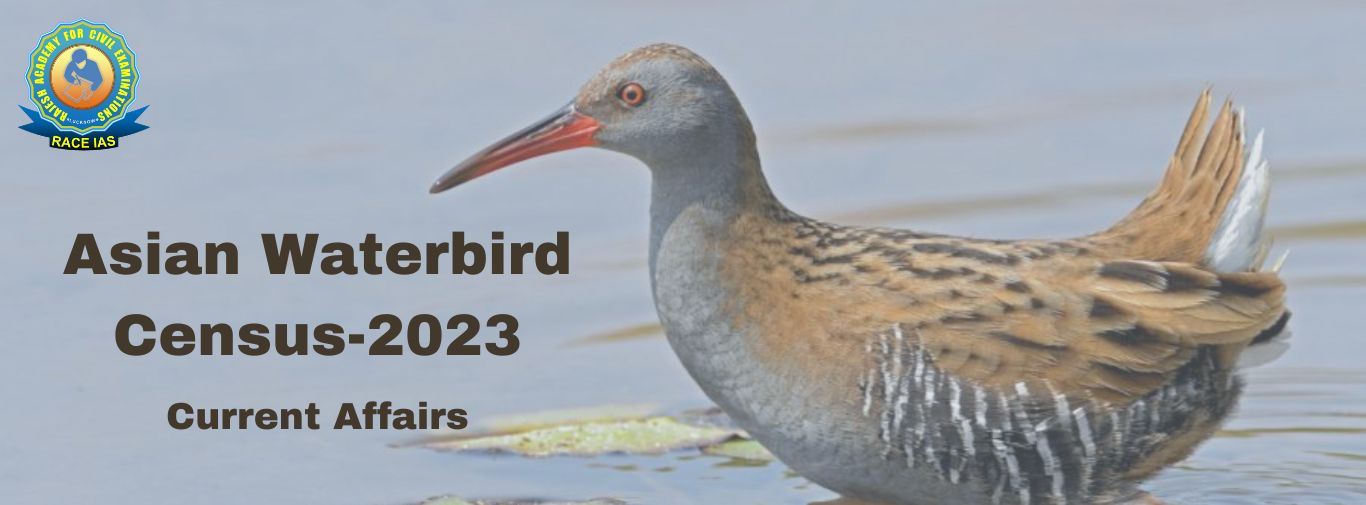
Asian Waterbird Census-2023
Asian Waterbird Census-2023: Urgent need for Environmental Conservation
Why in News?
- It is noteworthy that this time the Asian Waterbird Census (AWC) is to be done from January 7, 2023 to January 22, 2023. This is the largest annual waterfowl census of Wetlands International.
Key Points:
- Every year important work of bird census is done at different levels all over the world. 'Asian Waterbird Census' is also one of these. Under this, those aquatic birds that live in the wetlands of the Asian region are counted.
- India plays a big role in this census as India helps Wetlands International South Asia to complete this work through BNHS (Bombay Natural History Society).
- It is through this that a reference list of internationally important AWC sites and wetlands is provided to the AWC.
- This is done because birds are considered to be major components of the environment. Birds do the work of spreading seeds. In such a situation, due to the extinction of birds, the environment also comes in danger. Many bird species have become extinct and many are on the verge of extinction. In such a situation, protection of the environment can also be provided by protection of birds.
Importance:
- Waterbirds, which we call aquatic birds, have their own importance. Aquatic birds are one of the most important indicators of the state of the environment because their habitats are sensitive to climate change. Therefore water birds are one of the leading indicators of the health of wetlands. These birds warn about the changes in the environment and weather.
- The Asian Waterbird Census helps a lot in the conservation of species of water birds. At the same time, it also identifies the areas of wetlands around the world where these aquatic birds reside. Wetlands provide food, rest, roost and foraging habitat for these charismatic species.
- These waterfowl not only act as indicators of climate change, but also help us identify new wetlands on which these birds depend. This also helps us a lot in conserving those wetlands. This creates a virtuous cycle of environmental protection.
How is this Census done?
- This census is conducted by Wetlands International South Asia in coordination with BNHS (Bombay Natural History Society) in mid-January every year.
- It provides a reference list of internationally important AWC sites and wetlands in India. Similarly, in other places of Asia, the coordination of AWC makes the counting of aquatic birds possible.
Which areas are covered?
- This census is conducted all over Asia and Australia. Thousands of volunteers participate in this census as per international protocol and methodology. This citizen-science program supports the conservation and management of wetland and water birds around the world.
Purpose of census:
Monitoring the status of wetlands on an annual basis.
Encouraging citizens to learn more about waterfowl and wetlands.
Supporting local conservation activities for wetlands.
Data from this census and information is used to promote national water bird and wetland
conservation and international cooperation with the Central Asian Flyway and the East Asian-Australian Flyway.
In the Indian subcontinent, waterbirds are counted by the AWC at approximately 100 wetlands (State, Regional and National Wetlands, Ramsar Sites, Protected Areas, Important Bird Areas, Conservation Reserves and Community Reserves) in active coordination by a national network of volunteers .
What is the protocol for waterbird counting?
A general introduction to counting waterbirds is essential for the International Waterbird Census. In this sequence, participation of active volunteers from Delhi and neighboring states includes various institutions (Universities, Colleges), State Biodiversity Boards, NGOs, experienced volunteers in coordination with AWC Delhi State Coordinator.
Under this, the work of counting of aquatic birds will be started by including a total of nine wetlands in Delhi and National Capital Territory of Delhi. This includes the following sites:
Okhla Bird Sanctuary
Surajpur Wetland
Dhanori Wetland
Najafgarh Lake
Sultanpur National Park
Bhindawas Wildlife Sanctuary
Yamuna River
Sanjay Lake
National Zoological Park
Bombay Natural History Society:
It is India's largest non-governmental organization for the promotion of nature and natural resources. Its establishment itself. In 1883, under the guidance of Dr. Salim Ali (Bird Man of India).
Important Facts Related to Wetlands:
What is Ramsar site:
Ramsar sites are natural and artificial wetlands that are protected by the IUCN for their important role in ecosystems.
What is Wetland:
Swampy sites completely or partially surrounded by water are called wetlands, such as ponds, reservoirs, lakes, rivers, delta areas, mudlands, flood plains, swamp lands, rice fields, barrage lands and sea shores. marshy banks etc.
Mainly the transition area between water and land or marshy land surrounded by water is called wetland.
Importance of Wetlands:
- Wetlands are a very important part of the Ecosystem. They play an important role in environmental protection, ecological balance, oxygen production, carbon absorption, fisheries, irrigation, habitat for migratory birds, valuable wood products, food for dependent animals, water supply, flood prevention and biodiversity promotion.
- Wetlands around the world are protected under the Ramsar Convention. This agreement was done on 2 February 1971 in Ramsar city of Iran. This agreement is applicable from 21 December 1975.
- In the Ramsar list, Chilika Lake and Keoladeo National Park of Odisha in India were first included in the year 1981.
- The Ramsar Convention was signed by India on 1 February 1982.
- Currently, the state of Tamil Nadu has the largest number of Ramsar sites in India, with a total of 14 Ramsar sites.
- At present, a total of 75 wetlands in India have been included in the Ramsar list.
--------------------------------------------------------------------------------------------------------------
very useful article for UPSC/UPPCS
RACE IAS RTYUI
12-Jan-2023 12:45 AM